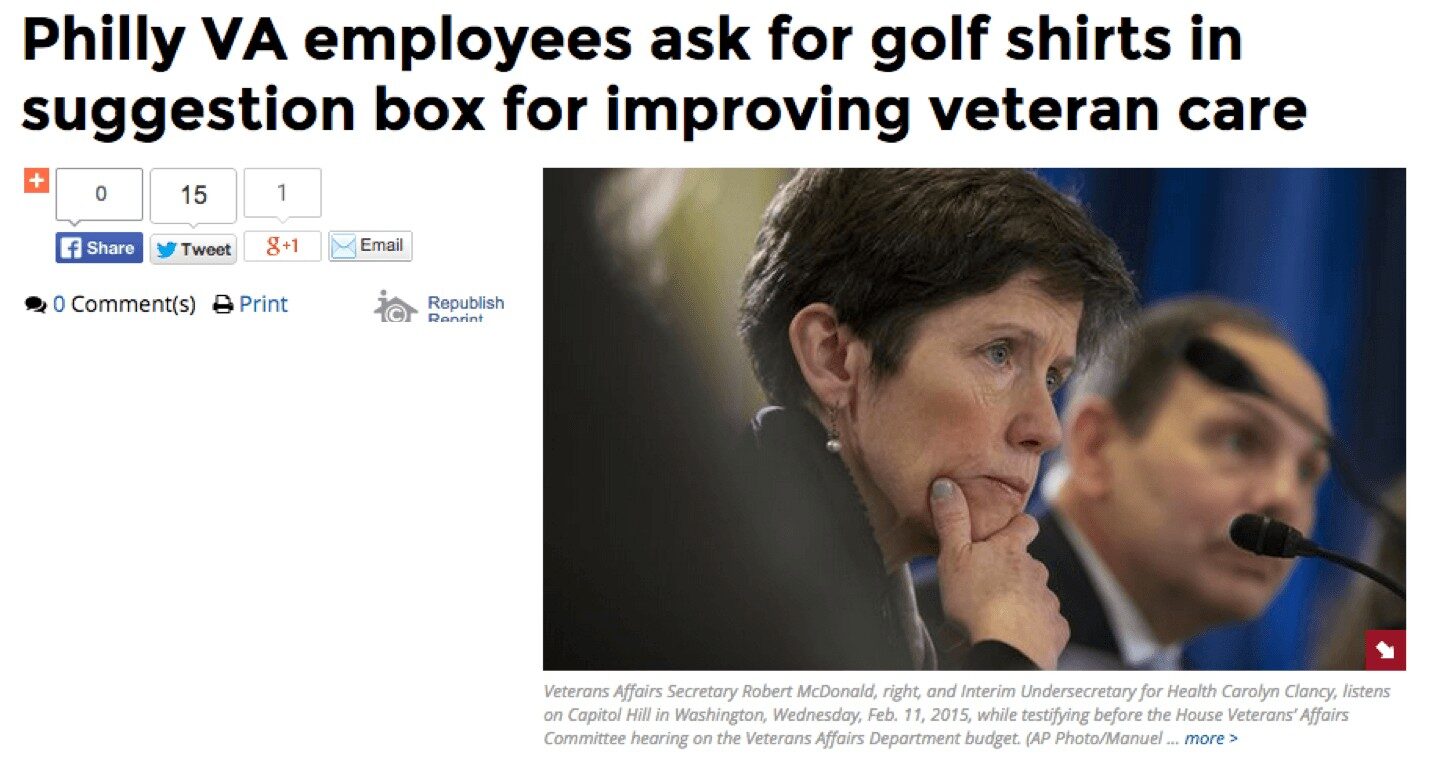This article caught my attention the other day: “Philly VA employees ask for golf shirts in suggestion box for improving veteran care.“

I hesitate to throw stones, but there are some very predictable dynamics involved here… and I will provide some ideas about a better approach and not just criticize.
Do you remember a few years ago when the U.S. federal government tried an online suggestion box program that basically just collected ideas to be rejected? That's very typical of suggestion box systems, whether they use a physical box or a website. Programs like this probably cause a net-net decline in morale since the leaders raise expectations (“we will listen to you”) and then disappoint people. The cycle of cynicism continues.
So, the aftermath of the VA scandals of 2014 (read my blog posts on this), the Philadelphia VA responded by creating a suggestion box.
Listen to Mark read this post (Learn more):
When a suggestion box is added to a dysfunctional workplace environment, employees usually ask for “selfish” things or things they want management to buy for them. When a workplace isn't properly aligned around the needs of patients or customers or when there's low trust between employees and management, I can't blame people for thinking “me, me, me.” People are going to make relatively safe requests like “new shirts, please.”
The Philly VA suggestion box supposedly asked for “suggestions for how to improve services for veterans” which is better than just vaguely asking for suggestions.
How many suggestions came in?
TWO
Again, that number was TWO.
Maybe the VA employees had read about the failed federal suggestion box and figured it was all a waste of time? At least somebody is learning.
One suggestion “asked management for “very stylish” golf shirts.” It's unclear how that would improve care for vets.
Now get this, the second suggestion:
“…critiqued the suggestion box itself, saying it was a waste of time because the VA never listened to suggestions anyway.”
You can't make this stuff up. If employees are so beaten down that they think management won't listen, then they're probably right to ignore the suggestion box. It was brave of somebody to suggest that the suggestion box was a waste.
Before the suggestion box was set up, employees had rightfully raised concerns about a new incentive program that had been established. The core, to me, of the 2014 VA Scandal was incentives that were given for hitting what the Office of the Inspector General called an “unrealistic” appointment waiting time goal. Predictably, people cheated the system and made the numbers look better than they really were. What other choice do you have when you're not well equipped to actually improve the system itself?
“[Regional Office Director] Ms. Rubens instituted the suggestion boxes last month after some employees complained that an incentive program to process claims quickly could lead to incorrect decisions and rushed work in an effort to collect bonuses — similar to waitlist manipulation discovered at the Phoenix VA last year that erupted into a nationwide scandal.”
Again, at least somebody is learning from the mistakes of the past.
“In canceling the incentive program, Ms. Rubens said she wasn't sure what else to do to speed up claims processing other than bonuses, so she said she was creating the suggestion box to solicit ideas on how to motivate employees to process 36,000 claims a year — a goal the office is already falling behind.”
Wow. Just wow. It's rare to hear a manager admit they don't know how to improve the operations they manage.
Instead of offering bonuses and incentives… they should improve the actual process! Look at how the work is being done. Look at the value stream of claims process. Engage employees in a Kaizen process, to actually identify and test improvements, large and small, to the work without them having to be run through some far off committee.
There are Lean practitioners in the military and different parts of the DOD and the federal government. Why aren't they drawing on those experts or outside folks? They really don't know what else to do other than use dysfunctional incentive schemes and outdated suggestion box programs? They replace one bad approach with another bad approach?
There are many of us out here willing to help, if the VA would just ask. That sounds like a great project to work on, with a noble and important mission. Those who don't know what to do need to get out of the way.
And, and get this… one reason they identified for the low number of suggestions was the intimidating location of the box… right outside the director's office:
“Ms. Rubens also said the box, which was placed near her office, had left employees uncomfortable.
“We are working to find a place that you will all feel comfortable submitting suggestions,” she wrote.”
But, if VA employees still think it's a waste of time, they're not going to participate. As Dr. Deming said, “substitute leadership.”
Please scroll down (or click) to post a comment. Connect with me on LinkedIn.
Let’s build a culture of continuous improvement and psychological safety—together. If you're a leader aiming for lasting change (not just more projects), I help organizations:
- Engage people at all levels in sustainable improvement
- Shift from fear of mistakes to learning from them
- Apply Lean thinking in practical, people-centered ways
Interested in coaching or a keynote talk? Let’s talk.
Join me for a Lean Healthcare Accelerator Trip to Japan! Learn More










Nice find Mark! So sad, yet so true.
VA has such a long road ahead from that dysfunctional state. The worst part is that people are intimidated from speaking up, that is the most painful problem to fix, as building trust takes a lot of time.
I’m sure they could benefit from Lean consultancy, but if I was in their management’s shoes, I’d try a very simple thing first: go to where the work is done, talk to people, identify one simple problem in their daily work, and make that obstacle go away. Next week, do the same thing at another team. Only bring in a consultant after doing this for a while.
Why do it like this? If they bring in a consultant now, it is unlikely that the employees participate fully, and even if they do, it puts the improvement program to a very difficult position: any failure at that point will rapidly degrade the trust even further. Getting some small wins, showing management commitment, and then bringing in a consultant to help the whole team do it better gives a better chance of success.
Furthermore, eventually the consultant will leave and the management and employees need to carry on doing improvements, and at that point it is better to be in a position where management commitment has been shown already before the consultant arrived so that there will be fewer doubts whether the improvement path is there to stay.
Thanks for your comment. I understand what you mean about many consultant-driven programs.
It’s funny, what you describe sounds just like the work that I’m doing with organizations based on “Healthcare Kaizen” principles.
I’ve found that’s easier said than done. Far too many leaders don’t know how to do what you described so well and they don’t have confidence in doing so. I play the role of coach, for them and their staff.
First off I would like to say I enjoy your blog Mark! I am a Veteran and a Lean practitioner. Hearing stories like this is troubling to say the least. Part of my frustration in hearing this is, it sounds like they don’t know about the government’s own Baldrige Award Program?
Here’s a Kaizen for the day: Use the governments Operational Excellence (OE) principals (Baldrige Criteria) to improve government programs (VA).
To be honest, I am more familiar with Shingo than I am with Baldrige, but from what I do know; in many aspects, both programs have a similar structure and goals. I don’t think the Baldrige program is used as much from a teaching/consulting perspective, but there is opportunity there for the VA to apply the principles used in the Baldrige Criteria to measure success when applying OE and improving the situation within the department.
Thanks for your service, Joe. The Baldrige criteria and that model requires leadership, just as other frameworks do. Does the VA have enough leaders and the right kind of leaders?
I just recorded a podcast with a civilian healthcare leader about the Baldrige process and their Iowa state Gold recognition. Baldrige and Lean go well together. That podcast will be coming soon to http://www.leancast.org.
[…] Article (and my blog post) about the VA suggestion system we discuss […]
I have a great suggestion for the DOD & VA which could save lives. Each time I read about veteran suicides I ask why are not both healthcare systems, DOD/VA, providing IV Ketamine to these military members? The data coming from other sources shows a profound and immediate positive effect for patients in preventing suicidal ideation.
Here is one recent article:
https://www.bloomberg.com/news/features/2019-02-05/ketamine-could-soon-be-used-to-treat-suicidal-ideation
Comments are closed.